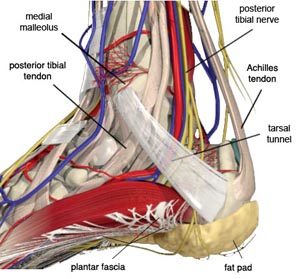Plantar Fasciitis is without a doubt the most common cause of heel pain - 10% of people are afflicted with it at some point in their lives. But if your heel pain continues for more than 2 months, it may not be plantar fasciitis at all.

Heel pain that lasts more than 8 weeks may be caused by a ligament tear in the heel, whose initial symptoms are almost identical to plantar fasciitis. However, the treatments for the two conditions are very different. In the case of a misdiagnosis, the treatment for plantar fasciitis can even make your heel pain worse.
Plantar Fasciitis or Plantar Fascia ligament tear?
Plantar fasciitis is a micro tear of the plantar fascia ligament, which occurs from overuse (too much demand on the ligament). A plantar fascia rupture (or tear) is less common and typically more painful. Pain from either injury will be felt in the bottom of the heel.
Even though the two injuries affect the same ligament, the treatment for plantar fasciitis vs. a plantar fascia tear are practically polar opposite. If you have a typical case of plantar fasciitis, the treatment protocol is usually stretching exercises via physical therapy, rest, ice, over the counter anti-inflammatories (ibuprofen or naproxen), and in some cases custom orthotics. If a patient follows the prescribed treatment, their plantar fasciitis will usually heal in 3-6 weeks.
Read more about plantar fasciitis.
But if your heel pain is caused by a tear to the plantar fascia ligament, those stretching exercises may make your condition worse. Healing a plantar fascia tear takes anywhere from 2-5 months, depending upon its severity. Treatment typically involves immobilization of the foot and lots of rest, to allow the tissue time to reconstruct without further stress. In some cases, surgery will be necessary to completely repair the ligament.
For this reason, a visit to a podiatrist is always recommended for heel pain. The subtle differences in these injuries can easily be missed by a general physician, and the wrong treatment can worsen your condition. Heel pain also puts more stress on the other joints in your body, as we shift weight off of our heel. It's common to develop pain in the ankle, knees and back as well when we have heel pain.
The best way to prevent heel pain is to be proactive. Wear supportive shoes to work and properly fitting and padded athletic shoes when you exercise. The key to protection is arch support and padding in the heel to absorb impact. It's also a good idea to do a proper warm-up before exercising, including gentle stretching exercises for your legs, ankles and feet.
